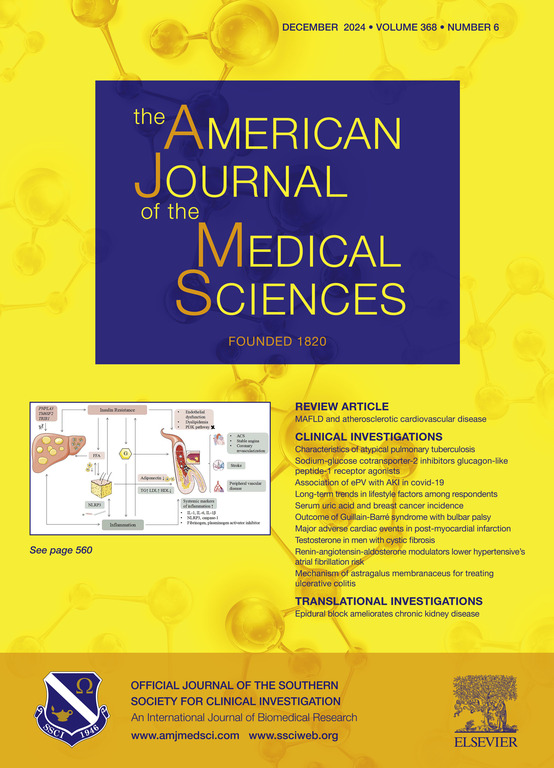重症患者谵妄的常见原因之一是再进食性低磷酸盐血症:一项回顾性研究。
IF 2.3
4区 医学
Q2 MEDICINE, GENERAL & INTERNAL
引用次数: 0
摘要
背景目的:探讨重症患者再喂养低磷血症与谵妄的相关性,并分析相关因素:我们对南京鼓楼医院2019年9月至2021年3月期间收治的重症患者进行了回顾性研究。将患者分为谵妄组和非谵妄组。收集并分析了患者的人口统计学数据、基础疾病、实验室检查结果、合并症、营养摄入和总体预后:共纳入 162 例患者,分为谵妄组(54 例)和非谵妄组(108 例)。与摄入营养素前的基线(Ppre)相比,两组患者在摄入营养素后的前三天(P1、P2、P3)血清磷水平明显下降。与非谵妄组相比,谵妄组的 P1 和 P2 明显降低。谵妄组在摄入营养素后头三天的血磷最大降幅(Pmax)明显高于非谵妄组。谵妄组的最大血磷下降时间为摄入营养物质后的第一天。多变量逻辑回归分析发现,营养的起始途径和P1< 0.845 mmol/L是危重症患者出现谵妄的独立预测因素:重症患者谵妄的发生率很高,且与再喂养低磷酸盐血症有关。第一天血清磷水平低于 0.845 mmol/L 时可能会出现谵妄。本文章由计算机程序翻译,如有差异,请以英文原文为准。
Refeeding hypophosphatemia is a common cause of delirium in critically ill patients: A retrospective study
Introduction
The purpose was to explore the correlation between refeeding hypophosphatemia and delirium and analyze the related factors in critically ill patients.
Methods
We conducted a retrospective review of critically ill patients admitted to Nanjing Drum Tower Hospital between September 2019 and March 2021. The patients were divided into delirium and nondelirium groups. Demographic data, underlying diseases, laboratory findings, comorbidities, nutritional intake and overall prognosis were collected and analyzed.
Results
In total, 162 patients were included and divided into delirium (n=54) and nondelirium (n=108) groups. Serum phosphorus levels in the two groups decreased significantly in the first three days (P1, P2, P3) after nutrient intake compared with baseline before nutrient intake (Ppre). P1 and P2 were significantly lower in the delirium group compared to the nondelirium group. The maximum blood phosphorus reduction (Pmax) in the first three days after nutrient intake was significantly higher in the delirium group than in the nondelirium group. The time of Pmax in the delirium group was on the first day after nutrient intake. Multivariable logistic regression analysis identified starting route of nutrition and P1< 0.845 mmol/L as the independent predictors of delirium development in critically ill patients.
Conclusion
The incidence of delirium in critically ill patients is high and associated with refeeding hypophosphatemia. Delirium may occur with serum phosphorus levels less than 0.845 mmol/L on the first day.
求助全文
通过发布文献求助,成功后即可免费获取论文全文。
去求助
来源期刊
CiteScore
4.40
自引率
0.00%
发文量
303
审稿时长
1.5 months
期刊介绍:
The American Journal of The Medical Sciences (AJMS), founded in 1820, is the 2nd oldest medical journal in the United States. The AJMS is the official journal of the Southern Society for Clinical Investigation (SSCI). The SSCI is dedicated to the advancement of medical research and the exchange of knowledge, information and ideas. Its members are committed to mentoring future generations of medical investigators and promoting careers in academic medicine. The AJMS publishes, on a monthly basis, peer-reviewed articles in the field of internal medicine and its subspecialties, which include:
Original clinical and basic science investigations
Review articles
Online Images in the Medical Sciences
Special Features Include:
Patient-Centered Focused Reviews
History of Medicine
The Science of Medical Education.

 求助内容:
求助内容: 应助结果提醒方式:
应助结果提醒方式:


